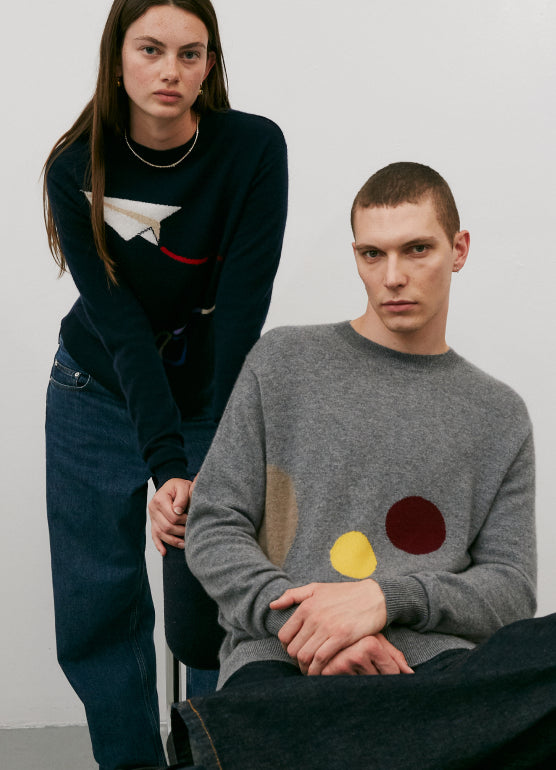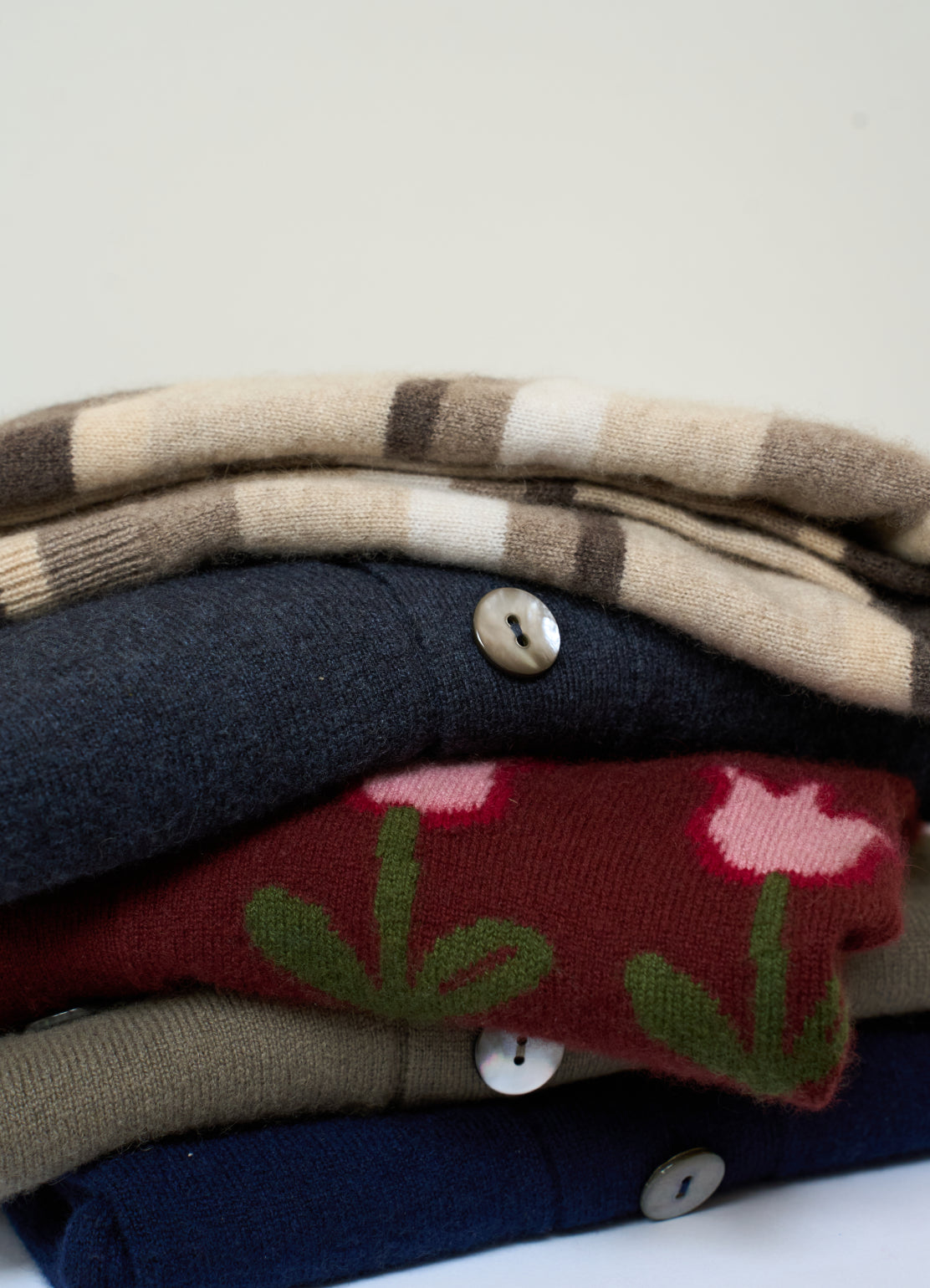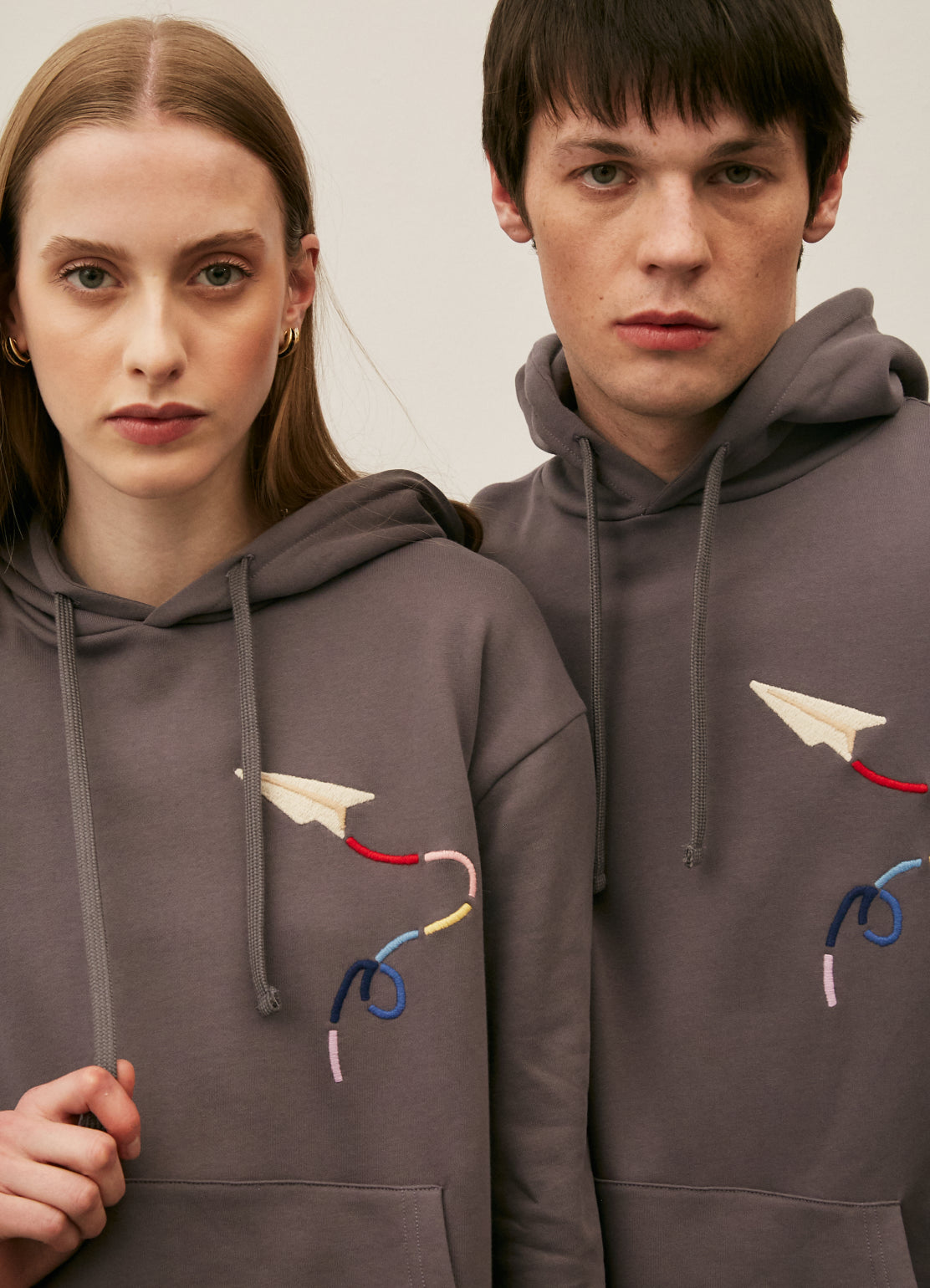Titus McBeath
Titus McBeath is a New York based Artist. Born in Ohio, McBeath holds a BFA from the School of Visual Arts in New York City.
His art features an array of objects, found and unfound, for his multimedia practices ranging from animatronic sculpture to painting.
Titus lives in Washington Heights, NYC where we photographed him in limited edition No. 2, No. 25, and No. 26.
Everything is directionless; what has happened before will happen again because it is already happening. LERET LERET's Executive Fashion Assistant Maya Kotomori interviews friend and prolific artist Titus McBeath on circularity, family, and corn.
 |
LERET LERET: All right. Tell us where you're from. You're from Ohio.
TITUS MCBEATH: Yeah, I'm from the Midwest, a little town called Findlay, Ohio. I hated being there when I was growing up, but after being in New York now for five years, I’ve grown to really appreciate where I came from, and I'm strangely proud of it. I miss it a lot.
LL: How many people were in your town?
TM: I guess it was pretty large for a small town, like 40,000 people, but it still felt really small. It was very “I'm your neighbor.” Everybody seemed to know everybody, the doors were always unlocked, kids running around, you know. It was weird.
LL: I mean, this is like a horribly city-slicker thing to say: but that's the beginning of a movie.
TM: Haha, I know what you mean. But it was normal for me growing up, I come from people who have worked there for their entire lives ya know. My dad has worked in the same factory there for the last 30 years. *points to hat*
LL: OH! That’s Cooper Tires? I thought that was a Cooper Union - that’s an insane hat.
TM: Thanks! Yeah, my dad’s been working in that factory, making tires all my life.
LL: Tell me about physically making a tire.
TM: There's like two main steps, I couldn't tell you exactly what those steps are, but I remember his job for a long time was at the first step machine. Now the technology has advanced so much, there is a new single man machine, where one person can do both steps. It was crazy to hear how he could make like 500 tires a day.
LL: Okay, so your dad is yoked.
TM: You would think that, but he’s just always tired (no pun intended). He’s a working man, you know - that's all he does. My parents [very much so] want to be working people. It's that Protestant work ethic, the idea that the harder you work, the closer you are to God, which has always been interesting to me.
LL: Titus, you have the most artist-y name. What are your family’s names?
TM: Yeah, that’s happenstance, my parents got my name from the Bible – Titus, is a small, lesser known book. My last name is McBeath. It's spelled McBeath like e-a-t-h but all my life my whole family always said Macbeth, like the play, you know? Fun fact, my immediate family all have ‘T’ names. My dad is Terry Lee, his dad is just Terry (no middle name for some reason), my mom Tammie, me Titus, and my older brother Trent.
LL: Like the Kardashians! What’s Trent like?
TM: We have a very interesting brotherly relationship, we didn't really get along as kids, but now we're pretty close. He's the one who really got me into art.
LL: How?
TM: I think I really "officially" realized that I wanted to be an artist through street art which me and my brother would bond over in our younger years. We loved those artists [who have become] cringey now like Banksy and Shepherd Fairey, it started this domino effect for me. Then we had the Toledo Museum of Art, which was an amazing place for me to go see contemporary art that was pretty close to where we lived. I’d go there with Trent and be like - what are all these shapes? You know, those weird pieces where you think why is this a painting? I remember going home once after seeing a Frank Stella at the museum, googling him and learning how he inspired an entire generation like - woah. His painting is in Toledo? Crazy. I learned so much from the Internet in that way.
 |
|
LL: In terms of visual culture and the Internet, how do you see reproducibility? And do you ever factor it into your work?
TM: The Internet has had a very large influence in my work. The Internet is the free exchange of ideas, that's how I learned about animatronics or robotics, I wouldn't know how to use most of the materials I use in my art practice today without the internet. Considering reproducibility, I think about how I’m using these materials that technically could last forever, you know, like weird little LCD screens that don’t need to be reproduced.
LL: Yeah, like we made those things. And we also made the Internet which is like a system that circulates images of these things that we also physically made... and continue to reproduce in factories that literally do not go away.
TM: Oh, it's very scary. Endless Reproducing.
LL: Do you see that as like, scary, scary, like dominant fear? How do you address that? Do you ever negotiate that in your work?
TM: When I was making the work I wasn't really thinking about reproducibility, but looking back I can see that it's definitely part of it; like single use objects in general. I feel like they’re a big part of the Midwest, like a part of throwaway culture.
LL: Ah, the “single use” conversation. Do you have any particular feelings about the word sustainability? Because I feel like you do.
TM: I think consumerism frames sustainability a certain way. A lot of the blame is put on the consumer for using things or for not disposing of things properly. It’s really the people who are producing that should bear the brunt of that.
LL: The [use of the] word sustainability is funny, because to sustain means to keep something at the same level. So what exactly are we sustaining?
TM: I guess that’s the question, yeah.
 |
LL: When I think about the single use materials in your work, the most profound to me is Doritos, which take it a step further - they’re not even single use, they’re literally consumable.
TM: Yeah! Chips are very funny objects. Even the bag has such a specific purpose, which is to hold the chips. In my work, I've been exploring corn chips specifically, like Doritos, Cheetos, Fritos.
LL: This man said “get more cheese than Doritos, Cheetos or Fritos.”
TM: What’s that from?
LL: Boy, Madvillain (rest in peace). I'm gonna play it real quick.
TM: Oh yeah, I’ve heard this before. That’s hilarious.
LL: Subconsciously powerful, Titus! Tell me more about chips.
TM: Haha, yeah! So, corn is one of the major exports where I'm from, most of Ohio is just corn fields, so I wanted to take a lot of time to analyze what corn is. There’s a whole culture behind corn, it's a fuel for a lot of economies, it’s used a lot in processed food, but I chose chips and junk food in general because that's where I saw the corn come back and restart its life cycle, almost.
LL: And then the Dorito physically becomes material in your work.
TM: Yeah, but not just any Dorito. I'll go through bags and bags and Doritos to find the perfectly shaped ones. I have a whole chip library in my apartment of clear Ziploc bags where I can see them and keep a catalog of the best ones.
LL: So you’re always eating imperfect Doritos?
TM: Yeah, haha! The chips I use become precious objects - I want people to be conscious of them. You maybe see a chip for two seconds before you eat it, but I'm literally making this process of searching through bags of chips, and elevating the perfect ones to be the subject matter of my work.
 |
|
LL: That’s beautiful. It's funny where things come from - ideas can be recycled and become completely different things. I think about that in your animatronic work too, and your other sculpture. How do you connect those two ideas? Where do you come from, in your art?
TM: I guess when I think about animatronics, I think about Disney theme parks. In college, I was looking at farming practices and how they’re becoming automated. I think about what my dad has dedicated his whole life to - working in a factory, now even that's becoming automated. There are little robots driving around his factory carrying things that will eventually overtake all the positions as workers. I wanted to somehow combine all these ideas into one work. The first piece I made using animatronic movement was this life size animatronic corn stalk that I made out of fabric and silicone. It slowly moved like it was being blown in the wind, and although it was simple, it made me want to do more.
LL: Wow! I think there's something to say about corn as an object for you, and its origins. What's next for you, Titus?
TM: What's next? I don't know. What I do know is that I love my job, I love my friends - I'm making new friends every day, and that's the best. I never thought my life would be this way when I was growing up in Findlay, it's like a dream, you know. I'm making art and meeting the coolest people in the world. Life is good – we’re all just moving around, like an animatronic corn stock in the digital wind.




